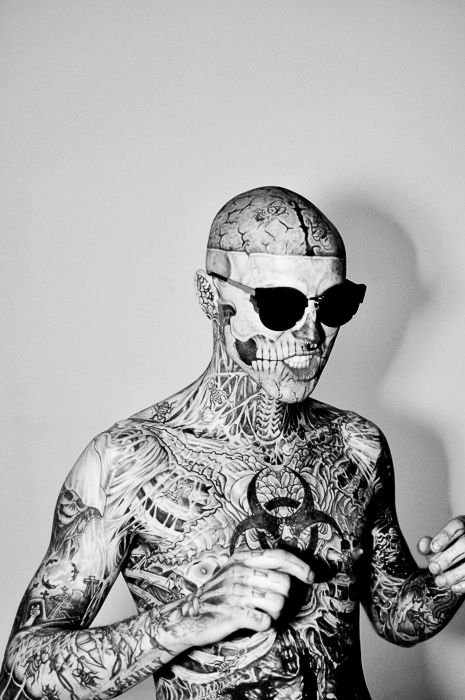
MONTREAL — While his unique head-to-toe body art propelled him to international fame on fashion runways and in a Lady Gaga video, the artist and model known as “Zombie Boy” never forgot his humble beginnings as a Montreal street kid, friends said Friday.
The artist, whose real name was Rick Genest, died at the age of 32, his talent agency confirmed Thursday.
Circus artist Jennifer Bobette, who knew him for 18 years, said the soft-spoken friend she called “Zombie” lived “two different lives.”
She said he never brought up his fame when he was home in Montreal, where he was part of a community of punks and artists living in a building known as the Fattal lofts near railroad tracks in the St-Henri neighbourhood.
“He had a famous life, where he was going and doing video clips with Lady Gaga, but when he was home at Fattal he was never talking about that, he became the Zombie we always knew,” said Bobette, who preferred to give only her stage name.
“He was putting on his… pants with 10 holes in them, and buying us beer and wine in the parking lot.”
She said the two met as teenagers at Dans La Rue, which ran a drop-in centre for homeless and at-risk youth.
At the time, she said her friend didn’t have a single tattoo and dreamed of becoming a circus performer — a dream he would realize some years later when he and some friends formed a travelling freak show.
Genest got his first tattoo at 16 and went on to eventually cover more than 90 per cent of his body in ink, including the image of a skull over his face.
According to his website, he holds the Guinness World Book of Records for the most insects tattooed on a human body (178), as well as the most bones inked on a human body, at 138.
But while his outward appearance may have been intimidating, he was unfailingly mild-mannered and polite, according to the CEO of the Welcome Hall Mission, a homeless shelter Genest visited as a teen and continued to support as an adult.
Sam Watts said he last saw Genest in June, when the artist lent his famous image to a campaign to raise awareness about the issues facing marginalized and homeless youth.
“This was a guy who put you totally at ease,” he said in a phone interview.
“Immediately you knew this was a kind and gentle soul who had some deep concerns about anybody who is on the fringes or being dismissed for how they looked.”
In early 2011, a photo of Genest in a fashion magazine drew the attention of fashion designer Nicola Formichetti, then the artistic director for French fashion house Mugler.
It was Formichetti who helped Genest secure his first major modelling gigs with Mugler and introduced him to Lady Gaga, who cast him in the video for her 2011 single “Born This Way.”
In their scenes together, the singer sported face paint that mimicked Genest’s tattoos as the two performed to the hit song in matching black suits.
Lady Gaga described the death, which she called a suicide, as “beyond devastating.”
“We have to work harder to change the culture, bring Mental Health to the forefront and erase the stigma that we can’t talk about it,” she said on her official Twitter account Thursday night.
Quebec’s coroner’s office said an autopsy would be conducted to determine the cause of death.
Despite the reports that Genest committed suicide, Bobette said her friend seemed his usual self when she last saw him a few days before his death.
But while Genest never expressed regret over his tattoos, she wonders if perhaps her friend had become a prisoner in his famous body.
“When you get tattooed as a zombie and you’re getting paid to show your body, maybe you become a prisoner and … who knows?” she said. “We’ll never know.”